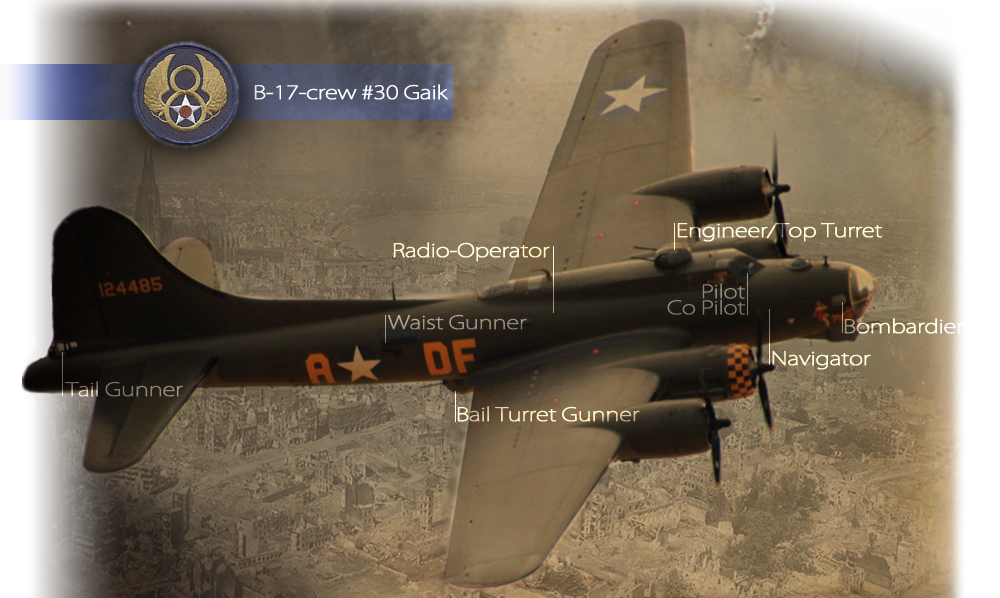[:us]
Waist Gunner:
The waist windows of the Fortress provided excellent defense stations; however, great skill or good luck was required to obtain strikes on an enemy fighter hurtling past. The waist guns were an important defensive feature of the B-17 formations, combining the open lateral areas with a gauntlet of massed firepower.
The waist gunners had flak helmets, flak suits and an armor plate contoured to the curve of the fuselage below the windows as their only protection from the flak and bullets. Standing at their guns, their bodies filled a larger target area than was the case for the rest of the crew, who were sitting or kneeling.
B-17’s carried two waist gunners; each protected his respective side of the aircraft. Waist gunners incurred the largest number of casualties of all the Fortress crew positions. Early waist gunner positions were directly across from each other, often causing the gunners to bump into one another and getting entangled in each other’s oxygen lines. Later, the positions were staggered, giving the gunners greater mobility. On early B-17’s, waist window coverings were on slide rails and had to be opened before combat so the guns could be swung out from their stowed positions. Improvements introduced on the B-17G mounted the guns to the inner frame of the windows and were enclosed with a permanent plexiglas covering, which meant the gunners didn’t have to stand in the freezing slipstream, as in earlier models. Later B-17’s had only 1 waist gunner instead of 2, so did crew # 30 Gaik.
| Eckerle, William C | Waist gunner
Engineer/Top Turret |
|
KIA 14-02-1945 |
| Prangl, Louis S
Staff Sergeant |
Waist Gunner
|
|
KIA 14-02-1945 |
[:nl]
Waist Gunner:
De waist gunner van de “Flying Fortress” zorgde voor uitstekende verdediging tegen aanvallers; al hoewel goede beheersing en/of groot geluk nodig waren om vijandige aanvallers te raken tijdens hun snel voorbijvliegen. De waist guns waren een belangrijk deel van de verdediging van een B-17 formatie, waarbij een strak patroon en de overweldigende vuurkracht voor de sterkte zorgden. De waist gunners droegen helmen (flak helmets), beschermende kleding en een gepantserde plaat gevorm naar het lichaam als enige bescherming tegen rondvliegend luchtafweer en kogels. Staande aan hun geschut vormden hun lichamen een groter doelwit dan de rest van de crew die zaten of knielden.
B-17’s hadden aanvankelijk 2 waist gunners; elk beschermde een zijde van het vliegtuig. waist gunners hadden het hoogste aantal ongevallen of doden van alle Flying Fortress-posities. In de eerste versies van de B-17 stonden de waist gunners precies tegenover elkaar, hetgeen vaak leidde tot ongelukkige momenten, zoalks het tegen elkaar aan botsen in een gevechtssituatie of vestrikt raken in elkaars zuurstofleiding.. In de latere modellen werden daarom de waist posities schuin tegenover elkaar geplaatst. In dce eerste modellen van de B-17 moest het raam geopend worden en het machinegewwer gemonteerd woden alvorends men het kon gebruiken; erg omslachtig en tijdrovend. Bovendien was het raam dan open en stond men lang in de ijskoude slipstream. In het B-17G-model werd het machiunegeweer in de binnenkant gemonteerd en het raam afgesloten met een permanent plexiglasscherm.
Aanvankelijk had een bemanning 2 waist gunners, maar aan het einde van 1944 stapte men onder andere door gebrek aan voldoende manschappen over op 1 waist gunner per crew, zo ook bij crew # 30 Gaik.
| Eckerle, William C | Waist gunner
Engineer/Top Turret |
|
KIA 14-02-1945 |
| Prangl, Louis S
Staff Sergeant |
Waist Gunner
|
|
KIA 14-02-1945
|

